Controlling Browser Preferences for DjVu
A report by PlanetDjVu, December 31, 2002
Introduction
Browser Preferences control the display characteristics of a DjVu file when it is opened and displayed in the web browser using the DjVu Plugin or the DjVu ActiveX viewer.
Here is a list of the preferences that can be controlled:
Display and Placement of Page Thumbnails (left, right, top, bottom)
Placement of the Toobar (top or bottom)
Toolbar Display (auto-hide or always visible)
Toolbar Buttons to Display
Startup Zoom (fit page, fit width, fit height, 300%, 150%, 100%, 50%, 25%, stretch)
Startup Mode (Default, Color, Black&White, Background, Foreground)
Document Alignment (Vertical and Horizontal: left, center, right, default)
Background Color (default, or select color)
Frame Visible (yes, no)
Logo Visible (yes, no)
Opening Page (specify page number)
Opening Rotation (0, 90, 180, 270)
Bookmarks visible (yes, no)
Metadata visible (yes, no)
Preferences can be controlled from three different sources:
By the DjVu document itself
By the web site adminstrator
By the end user at viewing time
Preferences Stored in the DjVu Document
Let's first take a look at setting preferences in the document itself. There are four applications that can be used to set standard display preferences:
DjVu Solo
DjVu Editor
Document Express Desktop or Professional Editions
JRAPublish
The preferences that could be set by Solo and Editor were identical, and let's assume that these same standard preferences are available in Document Express Desktop and Professional Editions. These controllable preferences, shown with screenshots from DjVu Solo, are:
Set the Startup Zoom
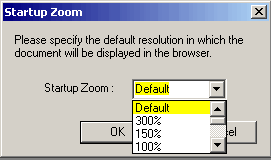 Set the Startup Mode
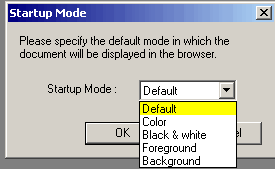 Set the Document Alignment
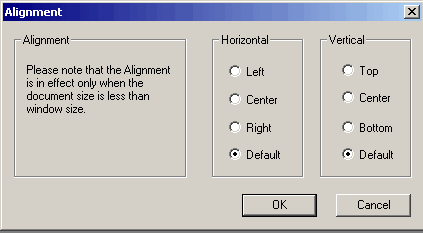 Set the Background Color
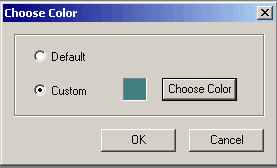 Now let's take a look at setting preferences in the JRAPublish application.
The standard controllable preferences are the same as above for Solo/Editor/Desktop, except that the preferences can be set for a batch of DjVu files as well as for just one file. The standard preferences are those that will automatically be applied by the DjVu web browser plugin when the DjVu is opened.
Startup Zoom, Startup Mode, Document Mode and Backgroud Color are set on the JRAPublih Open Tab
 JRAPublish also supports a set of advanced browser preferences that can be assigned to DjVu documents. These advanced preferences will not automatically be executed by the DjVu plugin, because they need to be applied by an external server application that controls the URL string for the opening of a DjVu file. These advanced preferences are executed with CGI-style arguments in the URL string.
The advanced preferences supported in JRAPublish are:
Display and Placement of Page Thumbnails
Frame Visible
Logo Visible
Opening Page
Opening Rotation
Bookmarks Visible
Use the Advanced Tab of JRAPublish for these advanced preferences
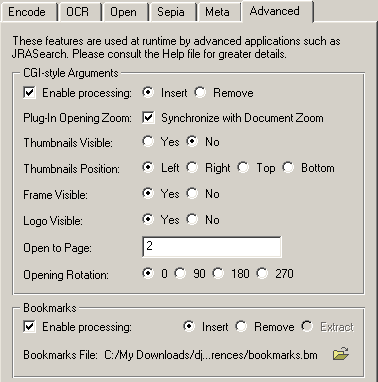 A final preference is a feature to syncronize the plugin default zoom with the document zoom. This feature prevents the double-display of the document when the default zoom is different than the document zoom. Otherwise, the document will first display at the plugin default resolution, and will then redisplay at the stored document resolution.
The advanced preferences, when stored in a DjVu file, can be read out of the DjVu file at runtime and executed by the JRMD Library, a web-server COM component. This COM component controls the URL link that is constructed to open the DjVu document. Thus, the preferences are executed not directly by the plugin, but indirectly, as the preference settings are read by an external program (the COM component) and then passed to the plugin as instructions by the URL string.
JRAPublish can store a bookmark structure and metadata (information fields) in a DjVu file that can be read and displayed in a separate web browser frame by SearchPDF and JRMD Library. JRAPublish is only commercial application that supports the creation of bookmarks and metadata in DjVu files.
The Meta Tab is used to embed metadata, and can also integrate thumbnails and generate hyperlinks
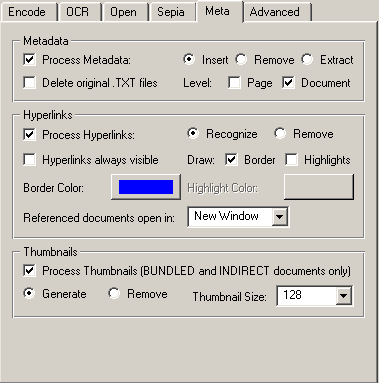 When metadata is embedded in DjVu with JRAPublish, SearchPDF or JRMD Library will display it in a separate frame
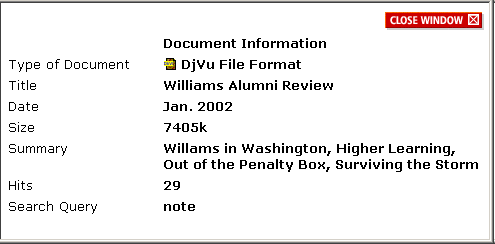 When bookmarks are embedded in DjVu with JRAPublish, the bookmarks can be displayed using SearchPDF or JRMD Library in a separate left frame
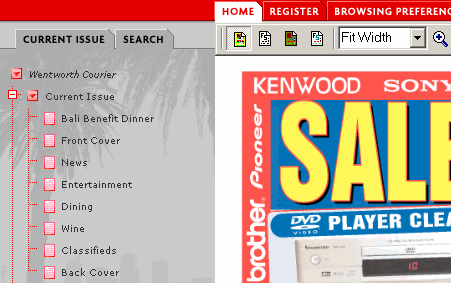 Preferences Set by the Web Site Administrator
The following preferences can be set by the Web Site Adminstrator, using CGI-style arguments:
Display and Placement of Page Thumbnails (left, right, top, bottom)
Placement of the Toobar (top or bottom)
Toolbar Display (auto-hide or always visible)
Toolbar Buttons to Display
Startup Zoom (fit page, fit width, fit height, 300%, 150%, 100%, 50%, 25%, stretch)
Startup Mode (Default, Color, Black&White, Background, Foreground)
Document Alignment (Vertical and Horizontal: left, center, right, default)
Frame Visible (yes, no)
Logo Visible (yes, no)
Opening Page (specify page number)
Opening Rotation (0, 90, 180, 270)
A complete set of examples using CGI-style arguments have been published in the News at PlanetDjVu. Click here to view these examples. These preferences can be set by the web site adminstrator for all DjVu documents, or they can be set separately for individual DjVu documents.
Preferences Set by the End User
Realview Technologies of Sydney, Australia, has implemented End User preferences for their DjVu digital publishing interface. The end user can set certain display preferences, which are stored in a Cookie and which can then be "remembered" and used to display the DjVu file according to the user preference. These end user preferences are applied to all DjVu documents on a website.
User preferences stored in a Cookie, which are then used by the server to construct appropriate CGI-style arguments when displaying a DjVu file.
 |